| 1727 |
Johann
H. Schulze, a German physicist, mixes
chalk, nitric acid, and silver in a flask;he
notices darkening on side of flask exposed to sunlight.
This accident created the first photo-sensitive compound. |
|
| 1780s |
Carl
Scheele, a Swedish chemist, shows that the changes in the
color of the silver salts could be made permanent through
the use of chemicals |
|
| 1826 |
A
French inventor, Nicéphore Niépce, produces
a permanent image by coating a metal plate with a light-sensitive
chemical and
exposing the plate to light for about eight hours. The photograph
was taken of a pigeon house and barn as seen from his window
in the summer of 1826 and
was made using a camera obscura and a sheet of pewter coated
with bitumen of Judea, an asphalt that when exposed to
light, hardened permanently. The photograph was
captured during an eight hour exposure, and took so much
time that the sun passed overhead, illuminating both sides
of the courtyard. |
 The first permanent
photograph, a landscape by Nicéphore
Niépce
The first permanent
photograph, a landscape by Nicéphore
Niépce |
| 1830s |
Louis
Daguerre, a French inventor, develops the first practical
method of photography by placing a sheet of silver-coated
copper treated with crystals of iodine inside a camera
and
exposing it to an image for 5 to 40 minutes. Vapors from
heated mercury developed the image and sodium thiosulfate
made the
image permanent. Daguerre is awarded a state pension by the
French government in exchange for publication of methods
and the rights by other French citizens to use the Daguerreotype
process. |

A dauuerreotype: L’Atelier de l'artiste.
1837,
by Louis Jacques Mandé Daguerre |
| 1839 |
A
British inventor, William H. Fox Talbot,
an English classical archaeologist, made paper sensitive
to light by bathing it
in a solution of salt and silver nitrate. The silver turned
dark when exposed to light and created a negative, which
could
be used to print positives on other sheets of light sensitive
paper. Talbot was the inventor of the negative/positive
photographic process, the precursor to most photographic
processes of the 19th and 20th centuries. |
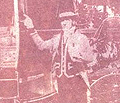 Detail from the Footman by Talbot, 1840
Detail from the Footman by Talbot, 1840
|
| 1840s |
Josef
M. Petzval, a Hungarian mathematician, develops lenses for
portrait and landscape photographs, which produce sharper
images and admit more light, thus reducing exposure time.
|
|
| 1851 |
The
British photographer Frederick S. Archer develops a photographic
process using a glass plate coated with a mixture of silver
salts and an emulsion made of collodion. Because the collodion
had to remain moist during exposure and developing, photographers
had to process the pictures immediately. Wet plate collodion
photography was much cheaper than daguerreotypes, the negative/positive
process permitted unlimited reproductions, and the process
was published but not patented. |
|
| 1861 |
The first color photograph, an additive projected image
of a tartan ribbon, is shown by James Clerk-Maxwell. Clerk-Maxwell
demonstrates a color photography system involving three black
and white photographs,
each taken through a red, green, or blue filter. The photos
were turned into lantern slides and projected in registration
with the same color filters. This is the "color separation" method.
|
 Tartan Ribbbon by Clerk-Maxwell, 1861
Tartan Ribbbon by Clerk-Maxwell, 1861 |
| 1871 |
Richard
L. Maddox, a British physician, invents the "dry-plate"
process, using an emulsion of gelatin, so that photographers
did not have to process the pictures immediately. By the late
1870s, exposure time had been reduced to 1/25th of a second.
Gelatin emulsion made it possible to produce prints that were
larger than the original negatives, allowing manufacturers
to reduce the size of cameras. |
|
| 1878 |
Eadweard Muybridge makes a high-speed photographic
demonstration of a moving horse, airborne during a trot,
using a trip-wire system and settles the "do a horse's
four hooves ever leave the ground at once" bet among
rich San Franciscans. |
 Courtesy of Wikimedia Commons
Courtesy of Wikimedia Commons |
| 1880 |
George Eastman, age 24, sets up Eastman Dry Plate
Company in Rochester, New York. |
 Dry Plate Box
Dry Plate Box
Courtesy of Eastman Kodak |
| 1880 |
The first half-tone photograph appears in a daily newspaper,
the New York Graphic. |
|
| 1888 |
George
Eastman introduces and mass markets the lightweight, inexpensive
Kodak camera,
using film wound on rollers. It is the
first easy-to-use camera. This camera contains
a 20-foot roll of paper, enough for 100 2.5-inch diameter
circular pictures. |
|
| 1891 |
Thomas Edison patents the "kinetoscopic camera" which
is used for motion
pictures. |
 Eastman and Edison
Eastman and Edison
Courtesy of Eastman Kodak |
| 1902 |
Arthur Korn devises practical phototelegraphy
technology (reduction of photographic images to signals that
can be
transmitted by wire to other locations); Wire-Photos are
in wide use in Europe by 1910, and transmitted intercontinentally
by 1922. |
|
| 1916 |
Kodak markets a lightweight folding camera. |
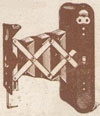 Courtesy of Wikimedia Commons
Courtesy of Wikimedia Commons |
| 1923 |
Doc Harold Edgerton invents the xenon flash
lamp and strobe photography. |
|
| 1925 |
The Leica introduced the 35mm format to still photography. |
|
| 1932 |
The first full-color Technicolor movie, Flowers
and Trees, is made by Disney. |
|
| 1934 |
The 135 film cartridge was introduced, making 35mm
easy to use. |
 Courtesy of Wikimedia Commons
Courtesy of Wikimedia Commons |
| 1936 |
Development of Kodachrome, the first color multi-layered
color film |
|
| 1948 |
Edwin H. Land introduces the first Polaroid instant
image camera. |
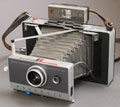 Courtesy of Wikimedia Commons
Courtesy of Wikimedia Commons |
| 1952 |
The 3-D film craze begins. |
|
| 1957 |
First digital image produced on a computer by Russell
Kirsch at U.S. National Bureau of Standards (now known as
the National Institute of Standards and Technology, or NIST).
http://www.nist.gov/public_affairs/techbeat/tb2007_0524.htm#image |
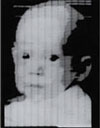 Credit NIST
Credit NIST |
| 1968 |
Photograph of the Earth from the moon was
transmitted back from space during the live television transmission
from the Apollo 8 spacecraft
on the third day of its journey toward the moon.
|
 Credit NASA
Credit NASA |
| 1975 |
The first
digital still camera was a prototype (US patent 4,131,919)
developed by Eastman Kodak engineer Steven Sasson.
It was made up of some Motorola parts with a Kodak movie-camera
lens and some newly invented Fairchild CCD electronic sensors.The
resulting camera was the size of a large toaster and weighed
nearly 4kg. Black-and-white images were captured on a digital
cassette
tape, and viewing them required Sasson and his colleagues
to develop a special screen. |
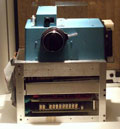 |
| 1978 |
Konica introduces first point-and-shoot, autofocus
camera. |
|
| 1986 |
Kodak scientists invented the world's
first megapixel sensor, capable of recording 1.4 million
pixels that could produce a 5x7-inch digital photo-quality
print. |
|
| 1991 |
Kodak markets the Kodak
DCS-100, a professional SLR
camera that was based in part on film bodies,
often Nikons. It used a 1.3 megapixel sensor and was priced
at $13,000. |
|
| 1992 |
Kodak announces Photo CD as a digital image storage
medium. |
 Courtesy of Wikimedia Commons
Courtesy of Wikimedia Commons |
| 2000 |
Camera phone introduced in Japan by Sharp/J-Phone |
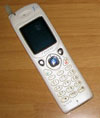 Courtesy of Wikimedia Commons
Courtesy of Wikimedia Commons |
| 2004 |
Kodak ceases production of film cameras |
|
| 2006 |
Polaroid announces it is discontinuing the
production of all instant film products, citing the rise
of digital imaging technology |
|
